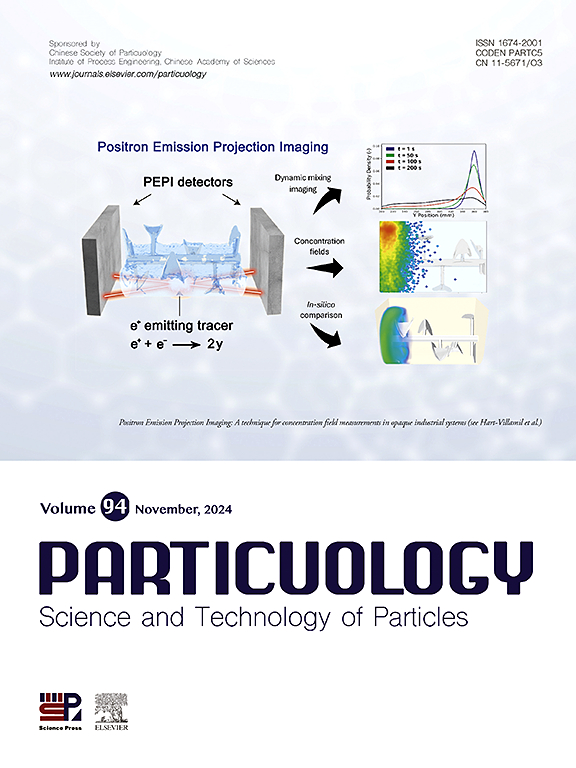Effects of particle size reduction due to wear on heat transfer in a fluidized bed: A CFD-DEM study
IF 4.3
2区 材料科学
Q2 ENGINEERING, CHEMICAL
引用次数: 0
Abstract
Particle wear behavior significantly affects combustion stability and operational costs. To reveal the underlying effects of particle size reduction on the heat transfer process, which are difficult to obtain experimentally, this study proposes a novel particle wear model. The model is experimentally calibrated and subsequently incorporated into a heat-fluid CFD-DEM platform. This is the first study to numerically investigate the impact of particle size reduction due to wear on the heat transfer characteristics in a fluidized bed. This study investigates the fluid dynamic and thermal behavior of particles after wear. It provides information on the system's macroscopic gas-solid flow regime (characterized by particle size and temperature distribution), the time-varying rules of particle wear and fragmentation rate, bed particle size distribution, and the relationship between single-particle diameter and temperature under different wear mechanisms. The primary innovation of this work lies in assessing the impact of different wear mechanisms on the key parameters (heating rate and temperature uniformity) during the heating process. Based on these findings, practical guidance is provided for optimizing industrial processes (adjusting particle flow patterns, optimizing debris distribution, and enhancing temperature monitoring at the bed bottom). The results reveal that different wear mechanisms lead to distinct distribution characteristics of particles within the bed. The abrasion mechanism enhances the heat transfer process, resulting in an approximately 16 % increase in the heating rate coefficient (C) and a 6 % improvement in temperature uniformity. In contrast, the fragmentation mechanism weakens the heat transfer process, leading to an approximately 33 % decrease in C and a 21 % reduction in temperature uniformity.

磨损引起的颗粒尺寸减小对流化床传热的影响:CFD-DEM研究
颗粒磨损行为显著影响燃烧稳定性和运行成本。为了揭示颗粒尺寸减小对传热过程的潜在影响,本研究提出了一种新的颗粒磨损模型。该模型经过实验校准,随后纳入热流体CFD-DEM平台。这是第一次用数值方法研究由于磨损导致的颗粒尺寸减小对流化床传热特性的影响。研究了磨损后颗粒的流体力学和热行为。它提供了系统宏观气固流动状态(以粒度和温度分布为特征)、颗粒磨损和破碎率的时变规律、床层粒度分布以及不同磨损机制下单颗粒直径与温度的关系等信息。这项工作的主要创新在于评估了不同的磨损机制对加热过程中关键参数(加热速率和温度均匀性)的影响。基于这些发现,为优化工业流程(调整颗粒流模式、优化碎屑分布和加强床底温度监测)提供了实用指导。结果表明,不同的磨损机制导致床层内颗粒的分布特征不同。磨损机制增强了传热过程,导致加热速率系数(C)提高了约16%,温度均匀性提高了6%。相反,破碎机制削弱了传热过程,导致温度降低约33%,温度均匀性降低21%。
本文章由计算机程序翻译,如有差异,请以英文原文为准。
求助全文
约1分钟内获得全文
求助全文
来源期刊

Particuology
工程技术-材料科学:综合
CiteScore
6.70
自引率
2.90%
发文量
1730
审稿时长
32 days
期刊介绍:
The word ‘particuology’ was coined to parallel the discipline for the science and technology of particles.
Particuology is an interdisciplinary journal that publishes frontier research articles and critical reviews on the discovery, formulation and engineering of particulate materials, processes and systems. It especially welcomes contributions utilising advanced theoretical, modelling and measurement methods to enable the discovery and creation of new particulate materials, and the manufacturing of functional particulate-based products, such as sensors.
Papers are handled by Thematic Editors who oversee contributions from specific subject fields. These fields are classified into: Particle Synthesis and Modification; Particle Characterization and Measurement; Granular Systems and Bulk Solids Technology; Fluidization and Particle-Fluid Systems; Aerosols; and Applications of Particle Technology.
Key topics concerning the creation and processing of particulates include:
-Modelling and simulation of particle formation, collective behaviour of particles and systems for particle production over a broad spectrum of length scales
-Mining of experimental data for particle synthesis and surface properties to facilitate the creation of new materials and processes
-Particle design and preparation including controlled response and sensing functionalities in formation, delivery systems and biological systems, etc.
-Experimental and computational methods for visualization and analysis of particulate system.
These topics are broadly relevant to the production of materials, pharmaceuticals and food, and to the conversion of energy resources to fuels and protection of the environment.
 求助内容:
求助内容: 应助结果提醒方式:
应助结果提醒方式:


